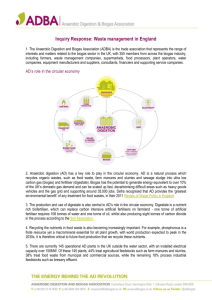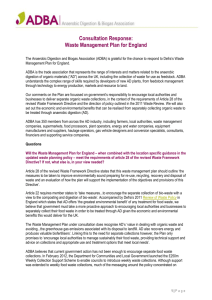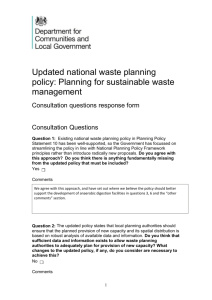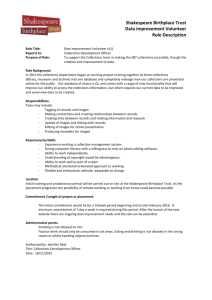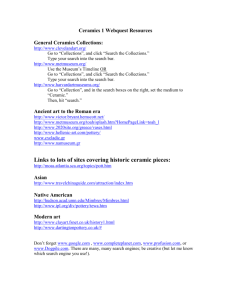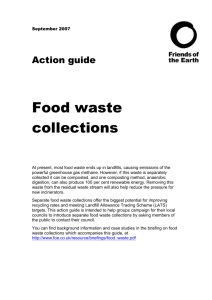1300924-Waste-Prevention-Programme-for-England
advertisement
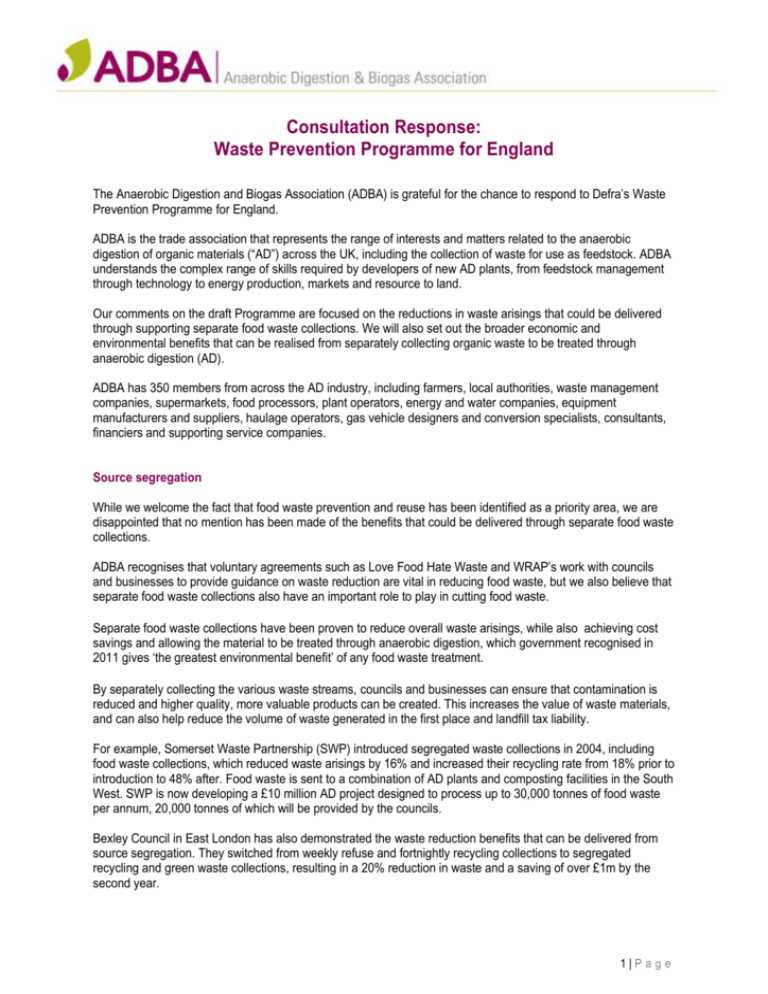
Consultation Response: Waste Prevention Programme for England The Anaerobic Digestion and Biogas Association (ADBA) is grateful for the chance to respond to Defra’s Waste Prevention Programme for England. ADBA is the trade association that represents the range of interests and matters related to the anaerobic digestion of organic materials (“AD”) across the UK, including the collection of waste for use as feedstock. ADBA understands the complex range of skills required by developers of new AD plants, from feedstock management through technology to energy production, markets and resource to land. Our comments on the draft Programme are focused on the reductions in waste arisings that could be delivered through supporting separate food waste collections. We will also set out the broader economic and environmental benefits that can be realised from separately collecting organic waste to be treated through anaerobic digestion (AD). ADBA has 350 members from across the AD industry, including farmers, local authorities, waste management companies, supermarkets, food processors, plant operators, energy and water companies, equipment manufacturers and suppliers, haulage operators, gas vehicle designers and conversion specialists, consultants, financiers and supporting service companies. Source segregation While we welcome the fact that food waste prevention and reuse has been identified as a priority area, we are disappointed that no mention has been made of the benefits that could be delivered through separate food waste collections. ADBA recognises that voluntary agreements such as Love Food Hate Waste and WRAP’s work with councils and businesses to provide guidance on waste reduction are vital in reducing food waste, but we also believe that separate food waste collections also have an important role to play in cutting food waste. Separate food waste collections have been proven to reduce overall waste arisings, while also achieving cost savings and allowing the material to be treated through anaerobic digestion, which government recognised in 2011 gives ‘the greatest environmental benefit’ of any food waste treatment. By separately collecting the various waste streams, councils and businesses can ensure that contamination is reduced and higher quality, more valuable products can be created. This increases the value of waste materials, and can also help reduce the volume of waste generated in the first place and landfill tax liability. For example, Somerset Waste Partnership (SWP) introduced segregated waste collections in 2004, including food waste collections, which reduced waste arisings by 16% and increased their recycling rate from 18% prior to introduction to 48% after. Food waste is sent to a combination of AD plants and composting facilities in the South West. SWP is now developing a £10 million AD project designed to process up to 30,000 tonnes of food waste per annum, 20,000 tonnes of which will be provided by the councils. Bexley Council in East London has also demonstrated the waste reduction benefits that can be delivered from source segregation. They switched from weekly refuse and fortnightly recycling collections to segregated recycling and green waste collections, resulting in a 20% reduction in waste and a saving of over £1m by the second year. 1|Pa g e As well as the environmental and economic benefits of separately collecting food waste, we believe evidence shows that weekly food waste collections have also proven popular with local residents. An Icaro study found that households who had a weekly food waste collection awarded the service 7.9/10. This compares favourably to the public’s overall attitude to their waste collection scheme, which averaged 7.4/10. A 2011 Friends of the Earth study also found that 82% of residents who had a food waste collection supported the service. Treatment of food waste through AD Government declared in their 2011 Review of Waste Policy in England that anaerobic digestion (AD) offered ‘the greatest environmental benefit’ of the main options for treating food waste. The AD industry as a whole would deliver 40 TWh of renewable gas annually if it reaches its potential in the UK. This would be worth around £2-3bn in itself, and the industry would support around 35,000 jobs. Over 60% of this potential is dependent on organic food and garden waste being diverted to AD however, and therefore government should play a more active role in supporting separate food waste collections. AD is the natural breakdown of organic material such as municipal solid waste, farm wastes, purpose grown crops and sewage sludge in the absence of oxygen. The process produces a renewable gas (biogas) and a biofertiliser (digestate) that can be spread to land, replacing synthetic fertiliser. Biogas (approximately 60% methane and 40% carbon dioxide) can be used for electricity and heat, or it can be upgraded to biomethane by removing the impurities and separating out the renewable CO2 which can be used locally or injected into the gas grid or used directly as a transport fuel. Compressed or liquefied biomethane is particularly valuable for HGVs, waste collection vehicles and buses for which there are few other renewable options currently available. Demonstrating the wider economic benefits of treating food waste through AD, WRAP has calculated that the nutrients in household food waste alone would be worth £50 million if spread to land as fertiliser, which anaerobic digestion facilitates. With mature markets the true worth of digestate, including its value as a ‘green’ product and the benefits it can offer to soil structure would be significantly higher still. Creating quality biofertilisers under existing British standards requires source segregation of food waste. If food waste is not source segregated then prohibitive environmental waste permits are required to use the digestate as a fertiliser. Good quality digestate recycling also makes an important contribution to the circular economy, recycling valuable nutrients such as phosphorous back to land, as was recognised in the recent report by the Ellen MacArthur Foundation titled “Towards the Circular Economy”. 2|Pa g e
